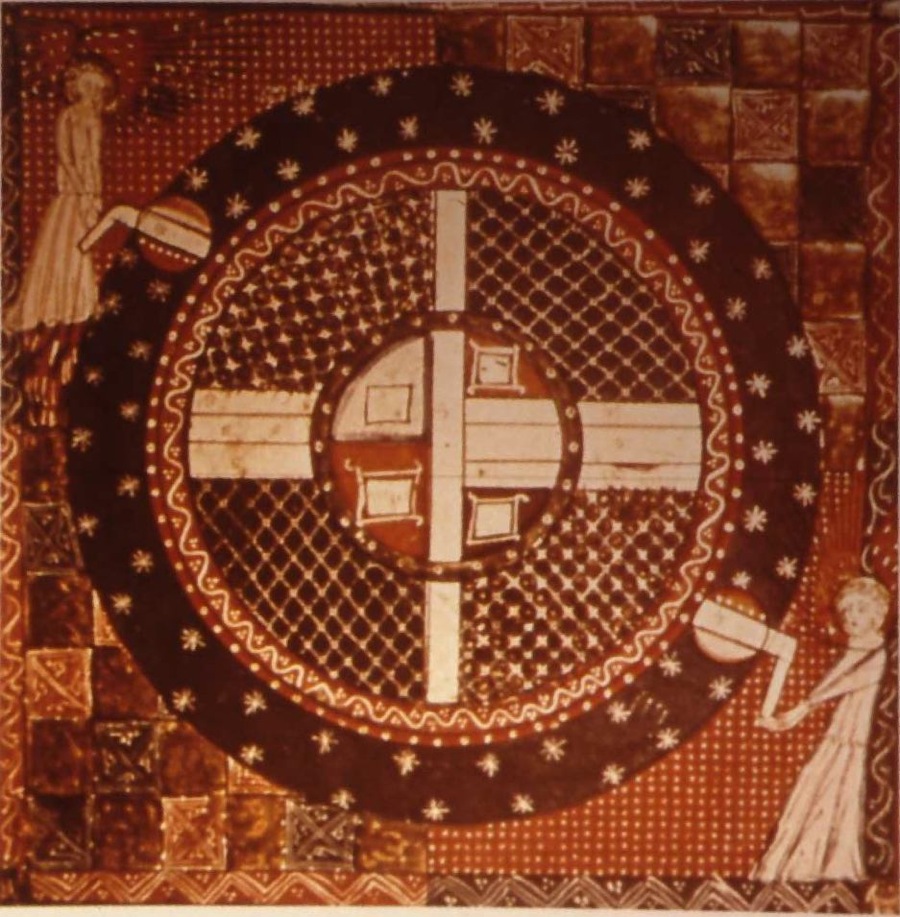

From "Was Ptolemy a Fraud?" in The Eye of Heaven by Owen Gingerich, 1993...."In some of the manuscripts, the Almagest begins with the epigram, 'I know that I am mortal by nature, and ephemeral; but when I trace at my pleasure the windings to and fro of the heavenly bodies I no longer touch earth with my feet: I stand in the presence of Zeus himself and take my fill of ambrosia, food of the gods.'
The epigram seems to place Ptolemy within the long series of scientists who have tasted the intoxicating pleasure of a splendid theory."
Picture left shows a concept of the universe after Ptolemy and before the 16th century. A giant machine with angels cranking it round.
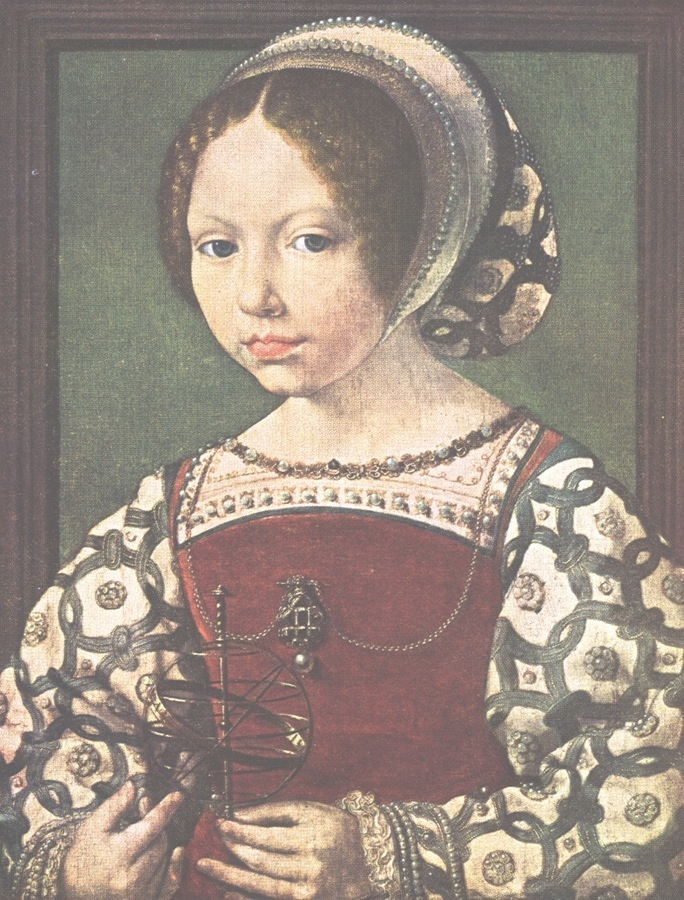 Picture right shows an unidentified girl by an unidentified artist painted in 1527 or thereabouts (looks a bit like the young Catherine de Medici who was a keen scholar and did have frizzy hair inherited from her African grandmother), holding her armillary which could be used for astronomical observation or timekeeping.
Picture right shows an unidentified girl by an unidentified artist painted in 1527 or thereabouts (looks a bit like the young Catherine de Medici who was a keen scholar and did have frizzy hair inherited from her African grandmother), holding her armillary which could be used for astronomical observation or timekeeping.
In "The Crime of Claudius Ptolemy" by Robert Newton, 1977, Newton states that the Almagest "has done more damage to astronomy than any other work ever written and astronomy would be better off if it had never existed."
From: Archaeology Yesterday and Today, by Jaroslav Malina and Zdenek Vasicek, Cambridge University Press, 1990, pp.242-243.
"Successors to Ptolemy managed to explain all the planetary movements unforeseen by his theory thanks only to their practice of adding any number of epicycles to planetary revolutions. Ptolemy's Effect means then that a wrong theory can explain anything if its basic erroneous propositions are altered and modified by a plethora of qualifications. The basic beliefs can in this way remain unchanged, while at the same time appearing to explain all the facts, which are qualified in advance anyway by the flexible application of terminology within a given ideology".
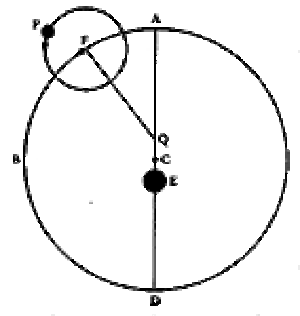 In their book "Fearful Symmetry", 1992, Ian Stewart and Martin Golubitsky show that Ptolemy's epicycles could produce accurate data for square orbits or any other shape.
In their book "Fearful Symmetry", 1992, Ian Stewart and Martin Golubitsky show that Ptolemy's epicycles could produce accurate data for square orbits or any other shape.
Picture left shows an epicycle.
Claudius Ptolemaeus was his real name. He worked as an astronomer at the Museum of Alexandria under government sponsorship. He used the roof of the temple of Sarapis as his observatory. His observations were made between 127 and 141 AD. The results were written up in the Megale Syntaxis Mathematike which was published around 150 AD. It was later known as the Almagest. He also wrote a geography.
In compiling his work on astronomy, Ptolemy selected material from earlier works especially that of Hipparcos, (published in Rhodes 127 BC.). This was a synthesis of predominantly Greek and Babylonian astronomy, and has as its basis the cosmological system devised by Aristotle, who had been tutor to Alexander the Great - a distinction which led prestige and ensured posterity to his many books.
The Aristotelian universe was seen as a perfect sphere. The Earth was in the centre, and all the heavenly bodies were fixed to solid but transparent (crystalline) spheres that fitted one inside the other (like Russian dolls) and rotated about the Earth like a cosmic machine. Models could easily be made of this which could be used as astronomical clocks and for calculations by astronomers. These were called armillary spheres and were usually made of metal with strips for the planets (which included the sun and moon) and the zodiac marking the path in the "fixed stars" along which the planets moved. Armillary spheres and astronomical clocks (water powered) were being made from before the first century BC in places from the Mediterranean to the Far East, but the Chinese and other Far Eastern astronomers did not believe that the universe was composed of solid spheres. They used armillaries and instruments based on them to observe the movements of the heavenly bodies, they did not take them as an actual model of the universe.
This meant Chinese and other Far Eastern astronomical observations were superior. In the concept of a solid, perfect unchanging universe there was no place for changing and new phenomena like meteorites, comets and supernova to appear, other than the Earth's atmosphere. There could be no changes and new discoveries. This cosmic system fitted well into Jewish, and subsequently, Muslim, and by the 13th century, Christian theology, so to disagree was to be a heretic, with a heretic's nasty fate. Bruno was burned to the stake after beingimprisoned and tortured for eight years, Galileo forced to recant.
A major problem with the Aristotelian universe, was that the universe does not behave in the orderly manner that mathematicians prefer. Aristotle insisted that above the sphere of the Moon, only circular motion was possible. This accorded with Pythagorean ideals, that perfection, including of course, perfect geometry should exist in the heavens.
But - the planets were not observed to proceed in a uniform motion at even speed. Neither did they always seem the same size. They even appear to be moving backwards at times. For example Mars was seen to move faster when it was in Capricorn than when it was in Cancer, and to seem larger and brighter when it was going backwards. (This is because when it is near the Earth, the Earth overtakes it for a time. An explanation that had to wait until the early 17th century when Kepler, working on the problem of Mar's orbit, realised it, and all the other orbits must be elliptical and around the sun.)
Ptolemy explains at the beginning of his book, his assumptions about the universe:
Ptolemy had devised a mathematical system using geometry, which was an attempt to make the Aristotelian cosmology fit the observable data. Ptolemy's system failed to provide a reasonable explanation of planetary motions, neither did it actually accord with the Aristotelian system. But since it produced the correct results, it ensured the dominance of Aristotle's cosmology until the 17th century.
Ptolemy expanded on earlier attempts to make the system fit the observations and predict the orbits of the heavenly bodies. Other astronomers had added extra spheres, and additional circles of movements. The calculations were based on geometry, using circles and cords of a circle. In Ptolemy's methods the planetary orbits were calculated by assuming the planets moved in little circles along the larger circle of their orbit - spiralled along. This still did not fit the data. Circles within circles were added and an alternative centre point for the orbit other than the centre of the Earth also. There might be alternative centres of rotation for the smaller circles too. Separate calculations were required for each planet including the moon and sun and again for three spheres of fixed stars, one for the Zodiac.
Complicated as the system was, and with no relationship to reality - it worked mathematically.
The system would have given the correct mathematical results for any shape of orbit - square say. It was far from perfect though. Later astronomers spent much time recalculating and altering the system to achieve better results. They were reluctant to abandon it.
When Chinese and Western astronomers were working together at the great Mongol observatory of Maraghah, the system was modified and adopted by Chinese astronomers. Even after the overwhelming evidence against it by the improved technology of ascertaining parallax, the support of Copernicus's sun-centred system, Kepler's observations of the planetary orbits, and above all by the discoveries made with the telescope, the Roman Catholic Church still held out for a system they had once been reluctant to adopt. It was not until November 1992, that the Papacy admitted that Galileo had been right and the Earth did move round the Sun.
In 1753 Tobias Mayer who was working on improved tables for the moon's orbit, noted in a letter to Leonard Euler, fundamental discrepancies in Ptolemy's work. Ptolemy had claimed to have based his theory of the sun's motion on his own careful observations of the equinox on a date equivalent to 26 September 139AD. But later calculations showed that Ptolemy's time for the equinox was 30 hours late.
Mayer had found that the data had been taken from Hipparcos, and since Ptolemy had already built his whole system upon it he may have preferred to discard any of his observations that did not fit rather than start all over again. He may have thought no one would notice. Others also discovered that Ptolemy had fudged his data. Many of the results of his own observations and those copied from others were wrong. His models of the motions of the Moon and Mercury especially conflicted with the most elementary observation.
In the preface to his work "On the Revolutions of the Spheres" Copernicus referred back to precedents of a sun-centred system before Ptolemy. There were many examples. It is not always the best ideas that become the established ones.
In his thesis, "The Crime of Claudius Ptolemy" (1977), Robert Newton states that the Almagest "has done more damage to astronomy than any other work ever written and astronomy would be better off if it had never existed".
The maintenance of an established idea regardless of contradictory evidence has become known as "Ptolemy's Effect".
A model showing the positions of sun and planets against the "fixed stars" with graduated metal rings is called an armillary sphere. Since only one hemisphere is ever visible to an observer, it is possible to made a flattened model - called a planispheric projection. This flat model of the universe is called an astrolabe. Armillaries and astrolabes could be made with gears. Add a source of motive power and you have an astronomical clock. Clocks with gears driven by a water wheel or noria were in use more than two thousand years ago.
Astronomers had to report to the Chinese emperor each morning with the results of their observations the previous night and their portent. As any of the Emperor's children by any of his consorts could be made the heir to the throne, one of the tasks of the astronomers employed at Court was to draw up horoscopes for each child fathered by the Emperor at the moment of conception, as a guide to seeing which child would become the heir. As the Emperor's consorts were organized in strict ranking order to form a women's army with their attendance on the Emperor organized by lady secretaries and eunuchs, the astronomers had to have horoscopes ready according to the consorts in attendance each night, just in case. They could not stop the organization of the Emperor's bedtime routine if the night was cloudy. This encouraged them to develop the astronomical clock.The earliest we know about is that made by Zhang Heng, described earlier.
Buddhist monk and missionary, was commanded in 721 AD by the Chinese Emperor to compile a new updated and corrected calendar. I-Xing received this commission because he was interested in clocks. His pilgrimage to India for the purpose of collecting Buddhist scriptures enabled him to study the clocks in the monasteries there. Like the one in Nandi, one he described. On his return I-Xing updated the observatory by supervising and helping to design with the engineer Liang Ling Cean several new instruments including an armillary sphere with a sighting tube which was driven by clockwork. The purpose of this was to keep a record of the Moon's ascending and descending notes (that is where the Moon's orbit crosses the path of the Sun - called the ecliptic, for this this is when eclipses may occur). Therefore this instrument was to be used to predict the possibility of eclipses. the machine was finished in 724. It was very large and driven by a water-wheel. The sighting tube was the forerunner of the telescope before adequate lenses could be made for it, so this machine was the ancestor of the clock-driven telescope.
Ptolemy's cosmic system was accepted and therefore had been preserved by Jewish scholars, when the Christians destroyed the library in Alexandria and murdered Hypatia the Professor of Mathematics when she was on her way home after giving a lecture.
This meant that Ptolemy was also acceptable by Muslims as their religion had derived from Judaism. The tables were translated from Greek into Hebrew, Syriac and Arabic. Improvements were made. The Hakimite Tables were produced in 1007 in Cairo by the mathematician Ibn Yunus who is also noted for his studies of the oscillation of a pendulum. The constellations were completely revised by Abd al-Rahman al-Sufi (903-986), whose Book of Fixed stars was completed in 1009 by his son.
A college of Jewish and Muslim scholars in Toledo provided a Latin translation in 1175 for Christians.
The most famous of all water-driven astronomical clocks is the one made under the supervision of Su Sung in the 11th century, in Song dynasty China.
Su Sung was born in 1020 in Fujian province. Although he was interested in science, he made his career in the civil service.
In 1077, Su Sung was sent as an envoy to the Mongol Qidan kingdom (Liao Dynasty) to the north, whose capital city - Yanjing, was on the site of the modern capital of China, Beijing. It was then called Yanjing as it had been the capital of the ancient Yan kingdom.
At the Liao court, Su Sung found himself faced with an extremely embarrassing situation. He presented himself to celebrate the Liao Emperor's birthday which fell on the same day as the winter solstice - and found himself at the palace a day too early!
This was an awful face-losing situation. Su Sung was in a spot because he had to celebrate the solstice on the day ordained by his own Emperor. He discussed his predicament with the Liao astronomers and discovered that they were right and the Chinese calendar was wrong.
Su Sung reported back to his Emperor Shen Cung on his return. The Emperor had all the officials of the Astronomical Bureau fined and put to torture.
The inaccuracy of their data, however, was not entirely due to their inefficiency, but to the immense bureaucratic weight of the Chinese political system. In China all the astronomers had to belong to the Astronomical Bureau which was a government office, answerable to the Emperor, their work strictly laid out and controlled and under official secrets acts. Change and innovation in such conditions was difficult.
In 1086, the next Chinese Emperor Yuan Yu, ordered the renewal of the observatory equipment and the construction of a new astronomical clock which drove an armillary sphere. Su Sung, now 66 and Right Vice-Minister of the Ministry of Personnel, was given the task of supervising the making of the clock. Most of the actual work was done by engineer Han Kung Lien.
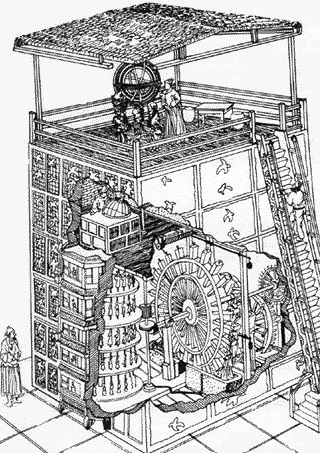 The clock was huge. A tower with stairs up which astronomers could climb to the observation platform, with the clockwork driven armillary sphere and various other instruments. Below the platform, inside the clock was a room with a celestial globe (showing the stars as if projected a a globe viewed from the outside, like the sky inside out) which was also driven by clockwork , and other instruments and a desk where astronomers could write up their notes. Passers-by outside would be able to tell the time and be entertained from tiers of revolving jacks (carved figures) which showed the time of day, day of month etc. The mechanical escapement was driven by a water-wheel. A full description of this clock with a reconstruction of the mechanism from Su Sung's notes can be found in "Heavenly clockwork" by Joseph Needham and others.
The clock was huge. A tower with stairs up which astronomers could climb to the observation platform, with the clockwork driven armillary sphere and various other instruments. Below the platform, inside the clock was a room with a celestial globe (showing the stars as if projected a a globe viewed from the outside, like the sky inside out) which was also driven by clockwork , and other instruments and a desk where astronomers could write up their notes. Passers-by outside would be able to tell the time and be entertained from tiers of revolving jacks (carved figures) which showed the time of day, day of month etc. The mechanical escapement was driven by a water-wheel. A full description of this clock with a reconstruction of the mechanism from Su Sung's notes can be found in "Heavenly clockwork" by Joseph Needham and others.
In 1088 a small working model of the proposed clock was ready for demonstration and experiments, but it was not until the beginning of the next reign, in 1094, that the clock was finished and installed at the palace observatory. By this time Su Sung was 75 years old, and had acquired many titles and honours in his successsful career in the civil service. In his memorial on the new clock to the new young Emperor Che Cung, Su Sung requested that the emperor give the clock a name, suggesting something on the lines of "the Cosmic Engine".
Su Sung died in 1101. In 1114, the Tungus-Manchurian Cherchen united under Aguta, conquered the Qidan and occupied Yanjing. The Qidan (also called Khitai, Russian for China, and in English Cathay), formed a new empire (the Kara Khitai) further west. In 1126 the Cherchen occupied the Chinese capital Kaifeng. They renamed Yanjing, Zhongdu (Central City) and ruled the empire from there as the Jin Dynasty.
The Jin built a new Imperial Observatory at Zhongdu and moved some of the instruments and Su Sung's clock from the observatory in the old Chinese capital. the instruments were installed on the observation platform of the new observatory and readjusted for the more northern latitude.
Su Sung's clock was still in use a century later when it was damaged in a storm. It was repaired and still working while the Cherchen were defeated by the new Mongol Empire found by Chinghiz Khan that was to stretch from the Adriatic to the Pacific. In 1212 Zhongdu the beautiful city of the Cherchen was destroyed by Chinghiz Khan. Very little can be seen today.
The governor of Zhongu, Yelü Chu-Cai, (1190-1244), a Qidan, was a faithful friend to Chinghiz Khan and to his son and successor Ogotai. He advised them on governing the countries they had conquered, he was also a noted scientist and compiled a set of astronomical tables. In these he followed the Arabic Ptolemeic system which was influencing Chinese astronomy, as a means of calculating the planetary orbits, although they did not believe the universe was made of solid spheres.
In 1251, Mongke a grandson of Chinghiz was elected Great Khan at the Mongol capital of Karakoram. His brother Kubilai was given charge of subduing the Chinese provinces and the Far East generally, while his brother Hulagu was sent in 1263 to the Near East, Iran, Iraq and the Caucasus.
The court at Karakoram was cosmopolitan with skilled workers from as far afield as England and France employed there. Mongke who was fond of the bottle, had as a centre piece in his court a silver drinks machine made by a Parisian silversmith called William Boucher. It was in the form of a tree. From the mouths of four lions at the base spouted into four basins, wine, koumiss, mead and saki. At the top of the tree an angel sounded a trumpet when the machine needed refilling. This device greatly impressed the monks sent as emissaries by King Louis IX of France and Pope Innocent IV in the hope that Mongke might become Christian and support their crusade against Islam. Mongke remained shamanist but unlike the Christians was tolerant of other beliefs.
Mongke's brother Hulagu relied greatly on the astrological forecasts of his shamans and astronomers of assorted religious beliefs and ethnic backgrounds, but did not tolerate mistakes. One of Hulagu's astronomers, Hossam-al-Din, a Sunni Muslim, who had been sent to him by Mongke, foretold great disasters, earthquakes etc. if Hulagu's army took Baghdad. He was foolish enough to give the exact date for these occurrences and stake his head on the result. The specified day passed peacefully for Hulagu but not for Hossam who was put to death. In his conquest of Baghdad in 1258, Hulagu had followed the advice of his Buddhist priests and the astronomer, Nasir-al-Din al-Tusi, A Shi'ite Muslim, Al-Tusi was pleased to see the end of his rival.
Hulagu's generals also had sought divine will by burning sheep's shoulder blades and looking at the pattern of the cracks. This ancient method of divination has left us with the oldest known Chinese astronomical records.
In 1259 when Hulagu had conquered Iran and most of the Near East and had acquired the title of Il-Khan, he felt he owed at least some of his success to the advice of his astronomers, Al-Tusi especially. Al-Tusi had petitioned Hulagu to sponsor a new, well-equipped observatory in order to compile new astronomical tables. In his petition he stated that the most recent tables available were 250 years old and out-of date. He stated that the compilation of new tables would take at least thirty years - this being the length of Saturn's orbit.
Hulagu told Al-Tusi he could build an observatory anywhere he wished. Al-Tusi chose Maraghah in Iran.
The main building was of circular construction and bisected by an enormous quadrant. This design was later copied by Ulughbek for his observatory in Samarkand. A number of eminent astronomers worked with Al-Tusi including: Muhyi al-Din al-Maghribi, Mu'ayyid al-Din al-'Urdi, from Damascus who designed and constructed many of the instruments, Qutb al-Din al-Shirazi, and Hulagu's Chinese astronomer, Fao Mun Ji, from whom Al-Tusi studied the Chinese system.
The tables that were calculated at this observatory were published in the next reign under the name of Zidj Ilkhani. (The Il-Khan Stars - after the Il-Khan Hulagu.) They showed an error of 40 minutes in the previous calculations of the Sun's place at the beginning of the year. The Ptolemeic system was used at Maraghah, but there was sufficient Chinese influence, to bring about some modifications.
Maraghah is claimed as the first observatory to be organized on an international basis, with teams of scientists from many different nations working together on the same projects. Hulagu became somewhat frightened at the expense of the observatory, the instruments of which alone cost 2,000 dinars. Al-Tusi managed to convince him it was money well spent, by a demonstration. Al-Tusi and Hulagu stood on top of a hill and Al-Tusi threw a copper bowl to roll to the bottom of the hill. The noise of this startled those who did not know what he was doing, while Al-Tusi and Hulagu were unaffected. "See the use of the stars" said Al-Tusi to Hulagu, "they announce what will happen, and those who know can take precautions, and are not panic stricken like those taken by surprise".
In 1260, Hulagu's brother Kubilai was elected Great Khan. Kubilai's chief adviser was Lin Pin-Chung (1216-1274) who quoted to him the ancient Han maxim: "You can conquer the world on horseback; you cannot govern it on horseback".
In 1267 Kubilai decided to move his capital from Karakoram to the remains of the old Jin capital Zhongdu. he entrusted Lin Pin-Chung with seeing to the move and the rebuilding of the city which the Mongols called Khanbalik (Khan's town) in in Chinese was called Dadu (Great City). In 1271, when Kubilai had conquered most of the Chinese provinces he established himself and his descendants as a Chinese Imperial dynasty with the name of Yuan.
Kubilai's Chinese capital city was cosmopolitan with citizens from many parts of the great Mongol empire and further afield. Among the Europeans who held official appointments was Marco Polo. In his book written on his return years later to Venice, Marco Polo states that Kubilai Khan employed five thousand astronomers at his court. Amongst the many beliefs in his capital Kubilai preferred Tibetan Buddhism and the lamas had a powerful influence in consequence. But the astronomers were from many religious and ethnic backgrounds. But Marco Polo observed that whatever their methods of ascertaining divine will, they all took the precaution of qualifying their predictions with the statement "It lies with God to do less or more according to his pleasure".
Since all the results were recorded as well as the predictions those astronomers who were proved the most accurate gained the most credit for their skill. Printed almanacs were published. This was long before printing in Europe. The almanacs were very popular and about four million copies were printed each year in three different sized editions and a Muslim version. At this time there would not have been that many able to read in the whole of Europe. The almanacs gave lucky and unlucky days, good days for holding weddings, making clothes, buying, building and other enterprises.
A new calendar had been compiled by an Iranian astronomer Jamal al-Din in 1267 and presented to Kubilai along with some beautifully crafted astronomical instruments.
The observatory built by the Jin had survived and been restored by Kubilai, but was now out of date. Su Sung's clock was still running, but it had become worn. The rings of the armillary sphere no longer ran smoothly. Kubilai decided to keep the old observatory as a museum and build a new modern observatory. He had as an example the observatory at Maraghah founded by his brother. The Maraghah observatory sent architectural models and plans for guidance in setting up the new observational equipment, not all of which was to be sited in the capital.
In 1276, the engineer Guo Shoujing (1231-1316) was given the task of reforming the calendar and reorganising the observatories for this purpose. Guo Shoujing had hitherto had the responsibility for arranging a supply of clean drinkable water to the new capital of Dadu, and also for improving the waterway transport with new canals linked to the Grand Canal, China's main transport artery.
Guo Shoujing supervised the setting up of twenty-seven observatories, over the country some with specialised purposes, the main one being in Dadu. One influence on their design from Maraghah was very large instruments, which enabled a more accurate calibration. Guo Shoujing built 12-metre high gnomens, one in Dadu, the others further south, which were housed in towers with the shadow measured along a horizontal graded scale. Inside the tower was also a water-powered clock and other observational equipment.
By 1280 Guo Shoujing had a new calendar ready, and many other results to present in a report to Kubilai Khan. One use for the observatories was in mapping the whole country accurately using a prime meridian of longitude.
Kubilai's interest in the heavens was for their divine messages. In the winter of 1293 to 1294, a comet appeared. Comets were though to foretell the death of a king. Kubilai then aged 80 was worried, and rightly. He died.
The man fated to be the last Yuan Emperor, Toghan Timur, was a keen horologist who designed his own clocks as well as collecting them.
A description survives of a clock designed by Toghan Timur, It was part of a state barge 120-130 long and 20-25 feet wide, rowed by 245 oarsmen magnificently dressed, It was carved to resemble a huge dragon - a live one! When the boat moved, the dragon's head, eyes, tongue, claws and tail moved too.
Toghan Timur used his unique dragon boat to journey on the canal between his winter palace in Dadu and his summer palace in the hills.
He shared space on his boat with a huge turret clock in the centre about 6 or 7 feet high which he had also designed. On top of this machine were golden characters reading Hall of the Three Saints. Inside was a statue of the goddess Yuniu which marked the hours. At each hour water flowed from a basin. On each side of the goddess was the figure of a spirit dressed in gold tissue, one held a bell, the other an instrument made of bamboo to strike the night hours, which were marked by a finger, while at every hour models of lions Jumped and models of phoenixes flapped their wings. On each side of the main turret was the "palaces of the Sun and Moon". In front of these were the figures of six immortals. At the sixth hour and midday they walked two by two, crossed a bridge called the Bridge of Spirits entered the Hall of the Three Saints and then returned to their places.
Toghan Timur had wide-ranging cultural interests. In 1333, for example, he sent a mission to the Pope "in Frankland beyond the seven seas where the sun goes down" asking for great horses (the ones used by the heavily armoured knights). These were sent to him.
But all was not well in the Chinese empire. Toghan Timur's reign was plagued by a series of natural disasters, floods, earthquakes and so on, which encouraged bandits, pirates and the support of nationalist, xenophobic groups. The leaders of the nationalist, quasi-religious, militant terrorist organisations set themselves up as messianic saviours and emperors.
One of these leaders came to dominate, this was Zhu Yuanzhang. In 1368 he set himself up as Hongwu the first Emperor of the Ming dynasty with his capital at present day Nanjing (Southern Capital). His general Xu Da drove Toghan Timur out of Dadu and renamed it Beiping (Northern Peace). Hongwu's son Zhu Di was made prince of Yan and given Beiping as his domain. but most of that city was destroyed by his father's troops. Toghan Timur greatly lamented the destruction of his civilised capital as he retreated back to felt yurts on the steppes to the north west.
Hongwu was not a cultured person and paranoid of those who were and any one or thing else he saw as threatening his position. He ordered history books to be rewritten, and great purges marked his reign. He had a clock tower in the centre of the city destroyed because he said such things were useless. When one of the royal astronomers presented him with a rock crystal automated clock, he smashed it. He burned books, murdered academics and politicians including his own supporters, drove out foreigners and foreign influences. Thanks to Hongwu, China lost its contacts with other civilised countries and received a cultural setback from which it was difficult ever to recover, appearing stagnant as other countries, particularly those in Western Europe, and also Japan, overtook it and forged ahead in science and technology.
During the Ming dynasty China was ruled by the palace eunuchs in collaboration with the palace women, who too suffered mutilation as the Ming insisted their ladies had tightly bound breasts and feet to keep them small. They controlled the tax collections, and the secret police.
The third Ming Emperor, Hongwu' s son Zhu Di, seized power with the help of the eunuchs who favoured him, and in 1403 was made the Yongle Emperor. In 1421 he transferred the royal court to his own city Beiping, renaming it Beijing (Northern Capital). He had to have the city rebuilt. The new city was designed on a square grid with the palace - the "Forbidden City" in the centre, This is the basic plan of the city as it is today.
 The Mongols blocked and controlled the trade routes from China to the west, so this may have been a motivation behind the several long overseas voyages made by Yongle's Palace eunuchs, many of them Muslim. The organiser of seven of these expeditions was a Muslim eunuch called Zheng He who had entered the service of Zhu Di when he was still prince of Yan, and had had several military posts before he was put in charge of the maritime expeditions.
The Mongols blocked and controlled the trade routes from China to the west, so this may have been a motivation behind the several long overseas voyages made by Yongle's Palace eunuchs, many of them Muslim. The organiser of seven of these expeditions was a Muslim eunuch called Zheng He who had entered the service of Zhu Di when he was still prince of Yan, and had had several military posts before he was put in charge of the maritime expeditions.
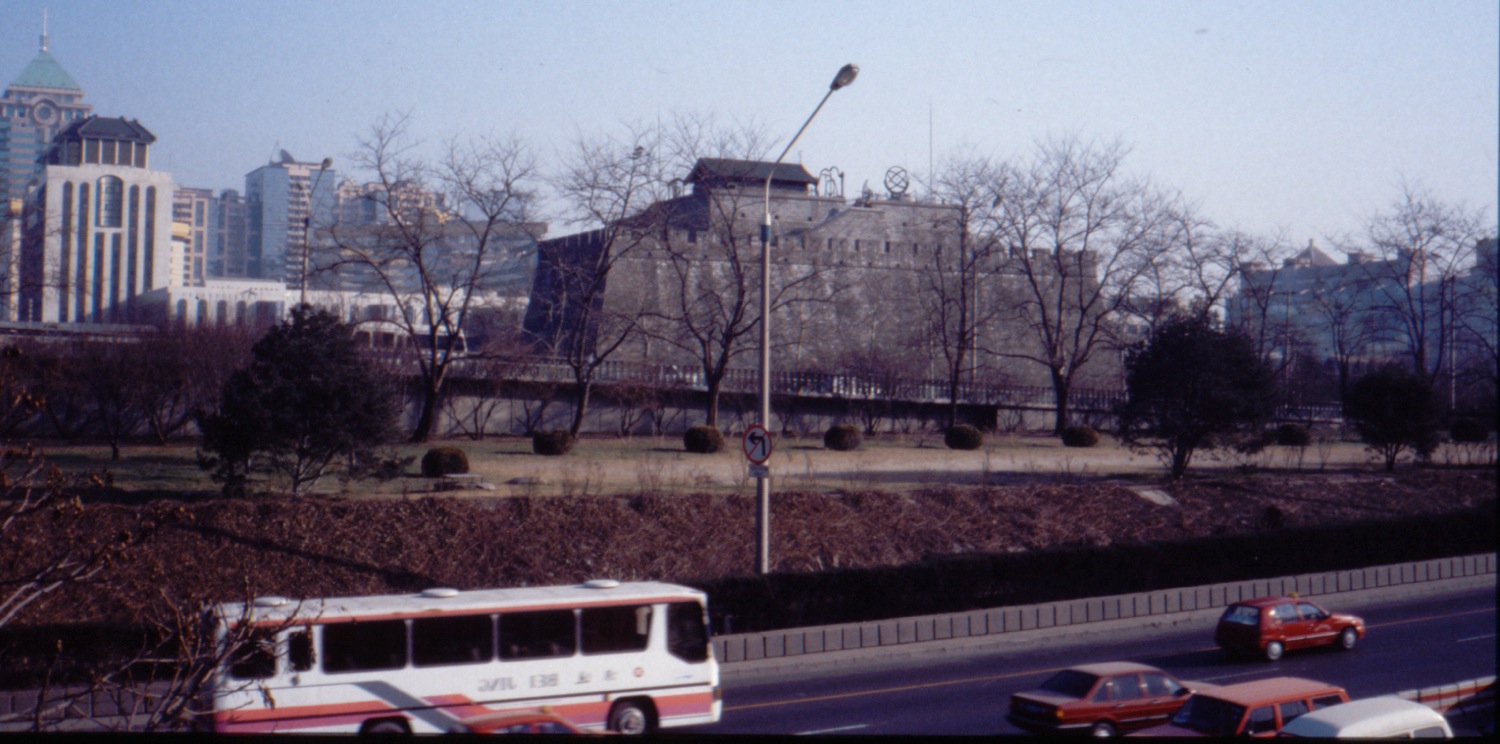 In 1437 in the reign of the Zhentong Emperor who inherited the same eunuch navigators, a new observatory was planned for Beijing. This is the observatory we can see today, by the Jianguomen flyover.
In 1437 in the reign of the Zhentong Emperor who inherited the same eunuch navigators, a new observatory was planned for Beijing. This is the observatory we can see today, by the Jianguomen flyover.The Board of Astronomy sent craftsmen to Nanjing to make wooden models of an armillary sphere which had been left over from the Song dynasty, an abridged armilla made by Guo Shoujing and a sundial from the same period. The models were taken back to Beijing and cast into bronze.
Buildings were constructed to house the instruments and for the astronomers to make their notes and records. These can be seen today. The observing platform was made on a gate tower in the city wall, There is a room below it which is now a souvenir shop. Across the courtyard and through a moon gate is an attractive garden laid out with other instruments and surrounded by the other buildings with traditional curved roof tops and red lacquered window frames. The buildings have such names as Sundial Hall and Hall of Celestial Abstruseness. Today they contain exhibitions showing the history of astronomy in China. (On our second visit the place had become very run down, and hope it has been or will be restored).
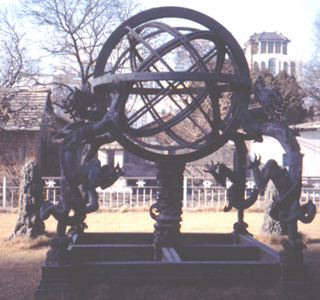 The last building and restoration of the observatory during the Ming dynasty was carried out in the middle of the 15th century. The instruments which were on the platform then included an armillary sphere, the abridged armilla copied from the one made by Guo Shoujing and a celestial globe. Below were a sundial and water-powered clock. By this time, weight-driven clocks were common in Europe but they were not known in China which was beginning to lose ground in technology to Europe. None of the instruments made for the Ming observatory appears to have been an original design,they were all copies of much older instruments.
The last building and restoration of the observatory during the Ming dynasty was carried out in the middle of the 15th century. The instruments which were on the platform then included an armillary sphere, the abridged armilla copied from the one made by Guo Shoujing and a celestial globe. Below were a sundial and water-powered clock. By this time, weight-driven clocks were common in Europe but they were not known in China which was beginning to lose ground in technology to Europe. None of the instruments made for the Ming observatory appears to have been an original design,they were all copies of much older instruments.
No more major overseas expeditions were embarked on after the mid-15th century by the Ming. They had also lost overland contact with other countries as the routes to the west were dominated by the Mongols who were able to control the trade.
In 1449, the Zhengtong Emperor Zhu Qizhen, abandoned by his eunuchs, was captured and held to ransom by the Mongol Khan Essen. Perhaps it had been too easy, since the Emperor's brother took over the throne and had no desire to see his brother returned. Essen was placed in the position of helping Zhu Qizhen back into his country. Meanwhile he lived with Essen's wives and his stay with the more emancipated Mongol women appears to have had one beneficial effect. On his return, he decreed that on his death the palace women would not be all be forced to kill themselves and their bodies thrown into a pit in the royal tomb.
Ulughbek and his observatory in Samarkand
Ulughbek's real name was Muhammed Targui. He was born on the 22nd March 1394, in the town of Sultania in Azerbaijan. His grandfather, Temur the Conqueror, was on a military campaign there at the time, and on hearing the news of the successful birth of a grandson, he was so pleased that he spared the lives of the defenders of a mountain fortress who had attempted to resist him.
Ulughbek's early years were spent with his parents following Temur's army on the trail of massacre and conquest, to Armenia, Afghanistan, India and China. On this last campaign, on 18th February 1405, Temur died.
The death of Temur was followed by war and chaos as separate members of his family struggled for power. In 1409, Ulughbek's father, Shah Rukh, Temur's youngest son, emerged victorious. He made his capital city at Herat, (in West Afghanistan) and handed Samarkand and the surrounding territory (approximating the country now called Uzbekistan) to his eldest son Ulughbek to govern.
Ulughbek was then 15 years old and had been married five years to a Mongol princess descended from Chinghiz Khan. The husbands of princesses descended from Chinghiz Khan were given the title of "Gurogani" (or Kurokhan) which is how Ulughbek's star tables came to be called the "Zidzhi Gurogani" (lit. Son in Law's Stars).
Ulughbek's parents were cultured people; patrons of the arts and sciences. Ulughbek had inherited from his mother, Gawhar Shad, a love of learning. Gawhar Shad founded mosques and a madrassah (a college) at Herat. Education for women was not encouraged, indeed it was considered indecent. Gawhar Shad got 200 women students into her college by a cunning strategy. She took the girls with her as her escorting ladies on a royal visit. During the visit one of the girls was discovered with a student in his room. Gawhar Shad thereupon insisted that all the students should be married immediately to each of her young ladies to save their reputations and avoid any such future incidents.
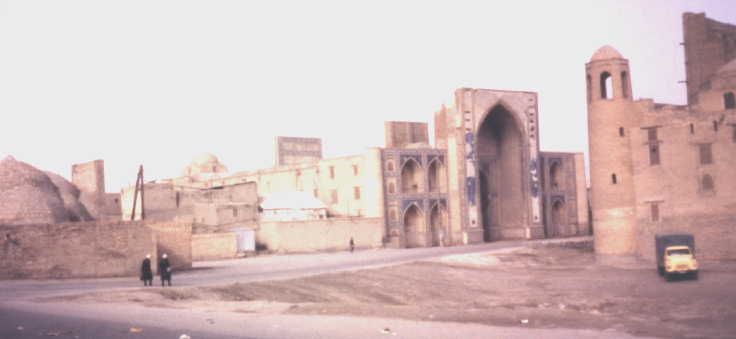 Thus education for women became at that time respectable. On the madrassah Ulughbek found in 1417 in Bukhara, is inscribed:
Thus education for women became at that time respectable. On the madrassah Ulughbek found in 1417 in Bukhara, is inscribed:
"It is the duty of every Muslim man and woman to acquire knowledge".
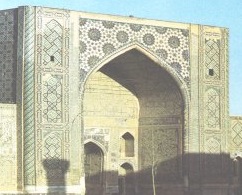 Ulughbek also founded the madrassah in Samarkand, which stands on one side of the Registan, the central square in Samarkand. The other buildings were added later.
Ulughbek also founded the madrassah in Samarkand, which stands on one side of the Registan, the central square in Samarkand. The other buildings were added later.
The Registan in the centre of Samarkand is one of the most beautiful historic city centres in the world. The facades of the buildings which are still being carefully restored, are covered in sparkling mosaics of coloured tiles. Over the front of the Ulughbek madrassah the tiles are arranged in a pattern of stars.
Inside the building, two stories of cloisters surround a paved courtyard with shady trees.
Ulughbek staffed his colleges with mathematicians, astronomers and philosophers, many of whom were internationally reknown for their work. Ulughbek himself was first a student then later a lecturer in his colleges.
The observatory was built during the years 1428 to 1429. When it was opened, Ulughbek's proud mother arrived on a royal progress especially to view her son's work.
For the next eight years, the astronomers at Ulughbek's observatory worked on compiling the star catalogue and tables, completing this work in 1437.
Two of the astronomers had been Ulughbek's lecturers at his college: Kazi Zada Rumi and Ghiyas ud Din Jamshid. When Jamshid died, his work was continued by Ulughbek and one of Ulughbek's favourite students Ali bin Muhammed Kushji.
Ulughbek used the cosmological system derived from Ptolemy's Almagest and modified later by the Islamic astronomers. The constellations were those in the book by al Sufi, completed and published by his son in 1009. The most recent star tables available to Ulughbek were the Ilkhan tables published in 1261.
Ulughbek wrote a preface to his star catalogue and tables. The preface gives practical and theoretical information in four parts. The first part explains how to determine the length of years and months including those of the Chinese and Uighur calendars. The second part explains how to measure the positions of the stars. The third part is on determining the positions of the seven planets. Included in this were chapters on determining the Distance of Sun and the Moon from the Centre of the World.
Also concerning the Moon was the section on "The Head and Tail of the Dragon". That is the Moon's ascending and descending nodes, the places where the path of the Moon's orbit crosses the plane of the ecliptic and eclipses of the Sun or Moon were likely to occur. Traditionally eclipses are caused by a dragon eating the son, and contemporary astronomical clocks in Europe marked this cycle with a dragon shaped pointer.
Ulughbek shows how to predict eclipses of the Sun and the Moon. This part of the book also gives the divisions of the signs of the Zodiac "The Twelve Celestial Houses".
The fourth part of the book deals with the making of horoscopes. This was one of the main functions of astronomy until the invention of the telescope opened the science to the exploration of the universe. Horoscopes formed an astronomer's main source of income.
The list of tables includes useful basic data, such as the latitudes of several major cities throughout the known world, including Spain, a large part of which was still under Islamic rule: the motions of the planets, eclipses of the moon, sine tables (trigonometry was the Islamic contribution and improvement to Ptolemy's geometry); conjunctions of the planets and so on. Plus of course, the catalogue of stars. Some of the data was copied from past works. The constellations and magnitudes of the stars were taken from al Sufi's Book of Fixed Stars and some of the tables were copied from the Ilkhan tables of al Tusi.
Ulughbek explains the formation of his star catalogue in his preface under the heading: Determination of the Places of the Fixed Stars in Longitude and Latitude:
"Before the time of Ptolemy 1,022 fixed stars had been observed. Ptolemy has given them in a catalogue in the Almagest. The stars are distributed in six magnitudes: the largest are of the first and the smallest of the sixth magnitude. Each magnitude is divided into thirds, and in order to recognize the stars, 48 figures or constellations have been imagined, of which 21 are north of the ecliptic, 123 in the Zodiac, and 15 south of the ecliptic. The larger number of the stars are within the figures, the others are in the neighbourhood, and are designated as unformed stars of the constellation.
Abd Al Rahman Sufi composed a treatise on the stars which all learned men have received with gratitude. Before determining by our own observations the position of these stars, we have laid them down on a sphere according to this treatise, and we have found that the greater part of them are situated differently from their appearance in the heavens. This determined us to observe them ourselves with the assistance of Divine Providence, and we have found that they were advanced from the epoch at which Sufi's work was written, so that on giving them, according to this general observation, their absolute position, we no longer found any difference from their appearance to the eye......
In our catalogue we have given the position of the stars for the beginning of the year 841 of the Hegira (1437), so that at any time we may be able to find the place of any stars on the supposition that they advance one degree in seventy solar years".
It can be seen from this abstract that Ulughbek's work consisted of updating and correcting existing established data. He did not put forward any new cosmological theories. Nevertheless he was to upset religious fanatics.
Just before the spring of 1447, Shah Rukh died. Abd al Latif seized the opportunity for power.
He forced his grandmother to follow the litter bearing her husband's body back to Herat, on foot, wearing an ordinary linen scarf on her head and supported only by a staff held in her hand. No doubt he hoped this would finish her off too.
Gawhar-Shad not only survived this treatment she managed to regain control over her grandson's forces, in Herat.
Ten years later she was to be murdered by a great nephew, Abu Said. Abu al Latif was not the only one with ambitions on the Empire after Shah Rukh's death.
While Ulughbek was leading his troops against rival claimants in Khorresan, Uzbeks under Abdulkhair Khan besieged Samarkand. They finally withdrew but not until after they had vandalized Ulughbek's collection of Chinese mosaics.
Men who did not like to be ruled by an academic. Men who lived by religious dogma not rational thought.
Ulughbek had stated:
"Religion disperses like a fog, kingdoms perish, but the works of scholars remain for an eternity".
This angered the religious extremists. In their propaganda against Ulughbek they said "He is insane! He compares religion with fog. He says that fog is dispersed. He means the end of Islam. He says that kingdoms collapse. Indeed, his kingdom must come to an end!".
The leader of the fanatical religious extremists plotting against Ulughbek was Hodja Ubaidulla Akrar, the head of the Sufi Nakshbendi order. Akrar was an extreme and violent fundamentalist opposed to any deviation from his own interpretation of the dogmas of Islam. In his campaign against Ulughbek, Akrar gained the allegiance of Ulughbek's son Abd al Latif who was looking for allies in his plans to wage war on his father in order to displace him.
Ulughbek like Bruno and Galileo and many other scientists was destined to become known as suffering martyrdom for his scientific beliefs against the entrenched religious conservatism.
The religious leaders and their followers, opposed to Ulughbek disapproved of the teaching and discussion of mathematics and foreign philosophies which went on in Ulughbek's colleges.
These opponents had prostelized for years without any effect, but Abd al Latif was now willing to make use of all his father's opponents whatever their personal motives, to gain power. He gathered on his side the fundamentalists and also those who were dissatisfied with Ulughbek for other reasons. Many joined him just because they thought the younger man was a better military leader. Ulughbek was forced to launch a military attack against his son Abd al Latif, which he lost.
Abu al Latif was now the Emir, but he had to get rid of his father entirely before he felt safe in his position. Amongst those he had collected round him who bore a grudge against Ulughbek was a man called Abbas whose father had been executed on Ulughbek's orders. Abu al Latif made plans…..
On the 27th October 1449, a cold wet day, Ulughbek left Samarkand, riding with the hadji (pilgrim to Mecca) who was appointed his companion and the few bodyguards who were left to him. They had not gone very far when a messenger overtook the group ordering them to turn to a nearby village to collect something necessary to their journey.
When Ulughbek arrived in the village he was seized by Abbas and beheaded.
His remains were buried next to the tomb of his grandfather Temur in the Gur Emir Mausoleum.
In 1941, both these famous bodies were exhumed by archaeologists. They were able to confirm that Ulughbek had been violently beheaded. A reconstruction was made of his head by Mikhail Gerassimov, who pioneered this method of forensic archaeology.
Abd al Latif managed to defeat his ambitious cousin Abu Said in the following year after Ulughbek's violent death, but then was himself assassinated.
Abu Said conquered Samarkand in 1452 and placated the Uzbek threat by giving Ulughbek's daughter Rabiga Sultan Begim, as a wife to the Uzbek Khan Abdulkhair. Abu al Latif's son joined his aunt and Abdulkhair to depose Abu Said. That is how the region was taken over by the Turkic speaking Uzbeks and was to become Uzbekistan.
It was too late to save the observatory. The religious fundamentalists had organized a fanatical mob to destroy and raze the entire building of Ulughbek's great observatory, at that time the biggest and best equipped in the world. The library of 15,000 books was looted, and the scholars driven out of Samarkand. The religious leaders declared the hill on which the observatory had stood, was the burial place of "forty maidens". They built a mausoleum to these "forty maidens" on this site and turned it into a lucrative centre for pilgrimage, hoping by this means to utterly destroy the memory of Ulughbek's observatory.
The remains of the observatory can be seen today. In 1908 the observatory buildings were excavated by a Russian archaeologist, V. L. Vyatkin. For Vyatkin the excavation of the observatory was his life's work, to the extent that he was buried here his tomb is right in the centre of the site.
The excavations revealed the circular plan of the observatory. From descriptions of it, it is known that the building was originally three stories high.
The building was bisected down the middle on the north south axis by an enormous altitude quadrant, an estimated 63 metres along its edge and with a radius of 40.212 metres. The lower part of this instrument survived to be excavated by Vyatkin, for it was cut into the solid rock of the hill.
This part of the quadrant, which visitors can see today, is 10 metres in height. It forms a narrow trench cut into the rock. The curved floor has steps for ease of access, cut each side of two parallel lines of bricks laid upon alabaster, forming a central trench.(see illustration). The two arcs thus formed are covered with marble plates 10 12 cm. thick. Both arcs are marked out to correspond with minutes and seconds for the measurements. The western arc also carries Arabic numerals.
A number of attempts have been made to reconstruct this impressive instrument and calculate how it was operated. One Russian paper suggests it was not a quadrant but a sextant, operated with mirrors.
Ulughbek copied the basic design of his observatory from the observatory of Maraghah in Iran, built in 1239 under the directorship of Nasir al Din al Tusi, and sponsored by Hulagu Khan, grandson of Chinghiz Khan. Hulagu was known as the Ilkhan in Iran hence the star tables produced at Maraghah were called the Ilkhan tables.
Very large instruments enabled more accurate calibration. Many such large instruments were made for observatories in the Far East during the Middle Ages and eventually in Europe. Tycho Brahe's observatory had a large mural quadrant built into the main building similar in design to that of Ulughbek's observatory.
A display of the instruments that might have been used in Ulughbek's observatory together with an outline of the history of astronomy before Ulughbek, is in the museum on the site. This is a round building constructed in 1970, and was designed to resemble the original observatory building. It is very much smaller and very much plainer too. The original observatory was once covered in sparkling coloured tiles. In the museum you can see copies of Ulughbek's star tables which were translated from the original Farsi (Iranian) into Arabic, Latin, French and English.
Ulughbek's work had not been lost to the world. Ulughbek's ex student, later assistant, Ali Kushji, who had been forced to flee from Samarkand took his copy of the star catalogue with him and had it published. Translations were made of the original text which was in Farsi (Iranian) into Arabic the lingua franca of the Islamic world.
By the end of the 15th century, Ulughbek's star catalogue and tables were used by astronomers throughout the Islamic world. The Ottoman Turkish astronomers in Istanbul were still using them in the 1580s.
In 1643, John Greaves, Savilian Professor of Astronomy at Oxford University, translated Ulughbek's work from Iranian and Arabic copies into Latin. But his work was never published. In 1655, Thomas Hyde, Librarian at the Bodleian at Oxford University, published a translation of Ulughbek's work collated from four manuscript copies.
By this time, however, the Ptolemeic system had been almost totally abandoned.
In the 18th century the Indian Prince Jai Singh, built several observatories with gigantic instruments constructed according to Ulughbek's calculations, but these were already too out of date to be of much practical use and were to become little more than impressive astronomical theme parks.
Although knowledge of Ulughbek's achievements came late to Western Europe, they did not go unrecognised.
More about Ulughbek and his Observatory in the booklet "Ulughbek and his Observatory in Samarkand" published by The Cosmic Elk, ISBN 171443180, which was updated from the article published in Astronomy Now, August 1988, and is now available as a pdf file free to download. Copyright Heather Hobden.
born 19 February 1473 - the youngest of four, at 17 St. Annes Street Torun (now 17 Copernika). In 1480 the family moved to a bigger house, 36 Market Square after his father became an alderman.
In 1483 his father died, and his mother's brother, Lucas Watzenrode, the Bishop of Warmia, undertook to pay for the education of his two nieces and two nephews - - for careers in the church.
The oldest sister managed to escape becoming a nun, she had a boyfriend and insisted on marriage - so she was the only one to have a legitimate family of her own. Her sister was to be a nun, and the two boys Nicolaus and Andrei were sent to the University of Cracow - to study in the faculty of Liberal Arts.
In 1496 their uncle sent the boys to Bologna to read Law - to prepare them for useful service in the church. In 1497 Nicolaus was made Canon of Warmia. In 1500 he was lecturing in Rome on mathematics. He returned to Poland in 1501.
Returned to Italy and became assistant to Domenico Maria Novara, Professor of Astronomy. He studied medicine at Padua for two years and learnt Greek. In 1503 he took his doctrate in Law but his main interests were mathematics and astronomy.
 The only image that suvives of what he looked like is based on his own self-portrait. With a broken nose and a scar above his his left eye - so he had not had a quiet life.
The only image that suvives of what he looked like is based on his own self-portrait. With a broken nose and a scar above his his left eye - so he had not had a quiet life.
His uncle now he had the training he had paid for expected him back as his secretary and physician at Lidzbark.
The cathedral was in Frombork. While Nicolaus accompanied his uncle to Court, he wrote his first draft of his astronomical system - it was copied out by hand and distributed that way, but not printed.
In 1512 Bishop Watzenrode died, to the joy of the Teutonic Knights whose enemy he was. Nicolaus went from Frombork to Olsztyn. Here he roused the peasants to take over and farm land devastated by the Teutonic Knights. In 1520 he fortified the town and castle of Olsztyn against the Teutonic Knights.
Nicolaus commanded the castle and they beat off the Teutonic Knights who devasted the rest of Warmia including Frombork. The room he lived in, in the castle has been restored. It opened on to the cloisters and on the wall, Nicolaus had made a sun-dial to use in correcting the calendar. He also used in his small observatory, a quadrant, armillary sphere and triquetrum.
He moved back to Frombork, to his Curia - Canon's house outside the walls of the cathedral close. In 1514, he had bought a tower and kept his library there. He did his observations at home on a brick platform in his garden. Of his wooden instruments that were made for him, the triquetrum was later owned by Tycho Brahe.
Nicolas wrote another treatise on astronomy and an almanac based on his new tables. Both were, like his previous work, not printed but distributed by hand-written copies.
From 1515, he was working on De Revolutionibus. His most influential and controversial work.
In 1519 Andrei, his brother died in Rome- he had been thrown out of Frombork as he had leprosy. Their sister Barbara, the Prioress of a Benedictine Convent in Chelmo had also died.
De Revolutionibus was finished in 1532 but he kept revising it. Hand written drafts circulated and it became well known although still not printed.
By the late 1530's Nicolaus was not only aging but becoming lonely as his closest relatives and friends died. His friend the Bishop Tideman Giese had been promoted and his new younger successor demanded that Nicolaus part with his "housekeeper" Anna Schilling "a married woman and her husband still alive". They had been together for many years and this was a cruel and unjustified attack on Copernicus, since his attacker, the new Bishop, Johannes Dantiscus, had a daughter by his own mistress Isabel Delgada. Anna was not just Copernicus's housekeeper and partner, she was an intelligent woman who shared his interest in astronomy. Copernicus had known her and her family a long time and was involved with a charity for children with her father. Anna owned her own house in Frombork but Dantiscus refused to allow her to live there even after Copernicus had died. Despite protests about Dantiscus' persecution of Anna from the other Canons - who also had "housekeepers" - and Dantiscus being himself a family man.
In May 1539, Georg Joachim von Lauchen (called Rheticus) Proessor of Mathematics and astronomy at Wittenburg, came to Frombork to meet the famous Copernicus and stayed with him. He had brought with him gifts of books including Ptolemy's Almagest in Greek. With its help Copernicus revised his manuscript. Rheticus copied it and took his copy with him when he returned to Wittenburg.
A summary had already been printed in Gdansk in 1540, then in Basel. It caused a sensation. Some Lutherans hated it. A Nuremburg printer, Johannes Petreus, encouraged by Andreas Osiander, a Lutherian theologian published it. But Osiander substituted Copernicus's own preface for his own unsigned one - so it looked like Copernicus had written it, in which he stated that the theories in the book were hypothetical only. The published work reached Copernicus on 24th May 1543, when he was seriously ill from a stroke, he died later that day. His possessions were inherited by the childen of his sister Katarina.
Most of "De Revolutionibus Orbium Coelestium" follows the same mathematical models that astronomers had used for centuries. His stated principles are similar to Ptolemy's to begin with:
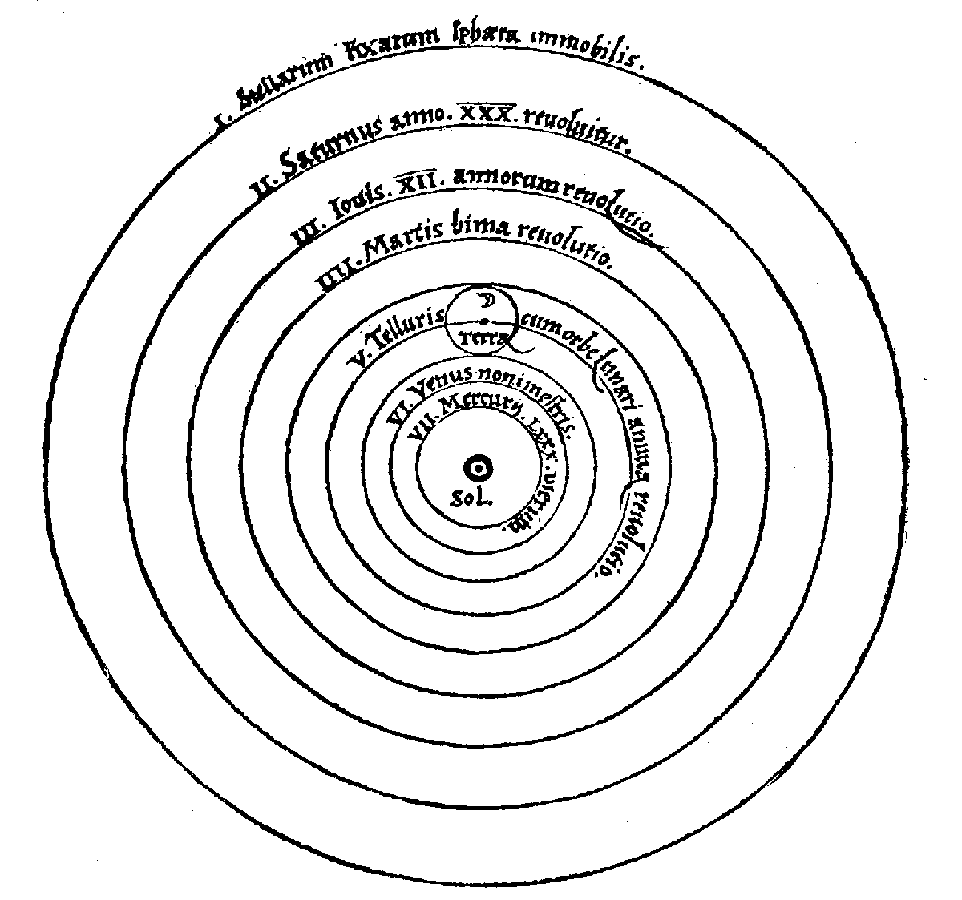 Copernicus had turned the Earth into one of the planets with the Moon still orbiting it, but it orbited the Sun between Venus and Mars and the Sun was in the centre of the Universe.
Copernicus had turned the Earth into one of the planets with the Moon still orbiting it, but it orbited the Sun between Venus and Mars and the Sun was in the centre of the Universe.
"In the middle of all sits the Sun enthroned. In this most beautiful temple could we place this luminary in any better position from which he can illuminate the whole at once? ...."
In his preface Copernicus states "I pondered long upon this uncertainty of mathematical tradition in establishing the motions of the system of the spheres. At last I began to chafe that philosophers could by no means agree on any one certain theory of the mechanism of the Universe, wrought for us by a supremely good and orderly Creator, though in other respects they investigated with meticulous care the minutest points relating to its orbits. I therefore took pains to read again the works of all the philosophers on whom I could lay hand to seek out whether any of them had ever supposed that the motions of the spheres were other than those demanded by the mathematical schools. I found first in Cicero that Hicetas had realized that the Earth moved. Afterwards I found in Plutarch that certain others had held the like opinion. ...
"The rest hold the earth to be stationary, but Philolaus the Pythagorean says that she moves around the central fire on an oblique circle like the Sun and Moon. Heraclides of Pontus and Ecphantus the Pythagorean also make the Earth to move, not indeed through space but by rotating round her own centre as a wheel on an axle from West to east."Taking advantage of this I too began to think of the mobility of the Earth; and though the opinion seemed absurd, yet knowing now that others before me had been granted freedom to imagine such circles as they chose to explain the phenomena of the stars, I considered that I also might easily be allowed to try whether, by assuming some motion of the Earth, sounder explainations than theirs for the revolution of the celestial apheres might so be discovered….."
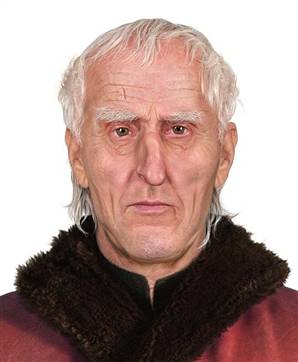 The translation is from: the RAS 0ccasional notes of 1943 reprinted 1947. A translation of the whole work was published in 1976, ISBN 071536927X.
The translation is from: the RAS 0ccasional notes of 1943 reprinted 1947. A translation of the whole work was published in 1976, ISBN 071536927X.
Copernicus' remains recently found - reconstruction of his skull ties in with his self portrait.
It was Pope Gregory XIII who finally got a committee together to get the calendar sorted in 1582. Eventually it was accepted round the world and is the standard calendar still not perfect we use today. See the Moon, Part 3
The Ming tombs are always included on a tourist trip to the Great Wall. The part of the wall which tourists see is the part rebuilt by the Ming which failed to keep out the Mongols when they were minded to besiege Beijing to enforce their trading contracts and horse fairs. (They seem to have lost interest in taking over the kingdom). The tomb tourists visit, the Dingling, was built by the Wanli Emperor in 1585, when he was only 22. It took 30,000 labourers toiling every day for six years to hollow out what looks like an anachronistic tube station and to finance this undertaking 8 million taels of silver, (equivalent to two years land taxes for the whole Empire or 1920 million kilos of rice) were extracted from already impoverished peasants and citizens.
Wanli celebrated the completion of his tomb with a grand banquet inside. It was 1620, before this underground palace became his final resting place with his two empresses, by which time the Ming dynasty was disintegrating.
The Ming had rigidly excluded foreigners, but in the 16th century, China was under siege.
To the north were Mongol and Cherchen armies. Pirates, Japanese and Indonesian assailed the coasts.
The Japanese were in Korea and the Portuguese in Macao on the Pearl River, which became the point of entry for Europeans determined to tap the wealth of China. In their attempts to reach China, Europeans had discovered America blocking the western route, got stuck at Bokhara (the British) as the Silk Road further east was blocked by warring Kazaks, and conquered Siberia (the Russians). The foreign armies, traders and pirates found allies amongst Chinese opponents of the Ming, whether dissident groups of academics or terrorist bands.
One thing they all had in common - they all needed guns, and the Europeans could supply the superior technology they had developed from the Chinese invention.
The bringers of this technology were the Jesuits, and it was the Jesuits who were the first Europeans to penetrate the Ming court at Beijing.
Their first mathematical school was established in Rome in 1551,just a few years after the Jesuit movement was founded. Although originally started by both influential men and women - women were soon excluded and the schools were for boys only. In 1581, Pope Gregory XIII gave the college in Rome university status.
One of the students was Italian Jesuit missionary, Matteo Ricci (1552-1610) who aimed to convert the Chinese emperor and his empire. He discovered that the best way to getting a passport to Beijing and acceptance at the Chinese court was by gaining respect as a scholar - espcially through astronomy and with gifts of western technology, especially ornate mechanical clocks and automations. The Chinese word for a mechanical clock is ZHONG. Ricci never managed to convert the Emperor to a Roman Catholic, but Ricci himself was to become a God of Chinese clockmakers.
As a Jesuit, Ricci did not accept the Copernican theory of a sun-centred universe which had been first published in 1543, but adhered to the Ptolemeic system. He rubbished Chinese science because it did not have solid heavenly spheres and had five elements - metal, wood, fire, water and earth, instead of the Western four, air, fire, water, earth.
Ricci arrived in Beijing on 25th January 1601 and lived in a house near the observatory where he died in 1610, the year Galileo was observing Jupiter's moons through a telescope.
Was born in 1546, a surviving twin. Father was governor of Helsingborg Castle, near that of Elsinore - Hamlet country. His uncle Joergen was a Vice-Admiral. He had arranged with his brother that if he had a son Joergen could adopt him for his own as he could not have children, but Tycho's parents changed their minds when Tycho born and his twin brother died. When Tycho had a new brother, Joergen kidnapped him. His brother threatened murder but accepted that since Joergen was rich it was useful that Tycho be his heir.
Tycho was sent to study rhetoric and philosophy at the University of Copenhagen when 13. Aged 14, a partial eclipse of the sun, gave him his interest in astronomy as he was impressed by the way it could be predicted.
While at university he lost his nose in a duel with another student to determine which was the best mathematician. Tycho after that wore a false nose that looked gold but was an alloy of gold, silver and copper - it made the scar round it green. Also it was very uncomfortable and Tycho always carried with him a little jar of ungent which he frequently rubbed on what was left of his nose. Later on his appearance got even more spectacular as he had a big bald head and a great handlebar moustache.
At 16, Tycho was sent to Leipzig University with a tutor to look after him who was aged 20, Anders Soerensen Vedel, a historian who was supposed to prevent Tycho pursuing astronomy. but gave up as Tycho persisted and they were friends. Tycho noticed that the planetary tables were not accurate enough and thought he could do much better. While Tycho at university, his uncle died after saving King Frederick II when he fell into the moat of his castle and Tycho inherited his fortune and was now very rich.
Tycho went on studying at Willenburg, Rostock, Basel and Augsburg until the age of 26. He collected astronomical instruments.
In 1570, he returned to Denmark and for the next five years lived with his uncle Steen Bille the only member of the family who approved of his interest in astronomy. Steen had founded the first paper mill and glassworks in Denmark and dabbled in alchemy.
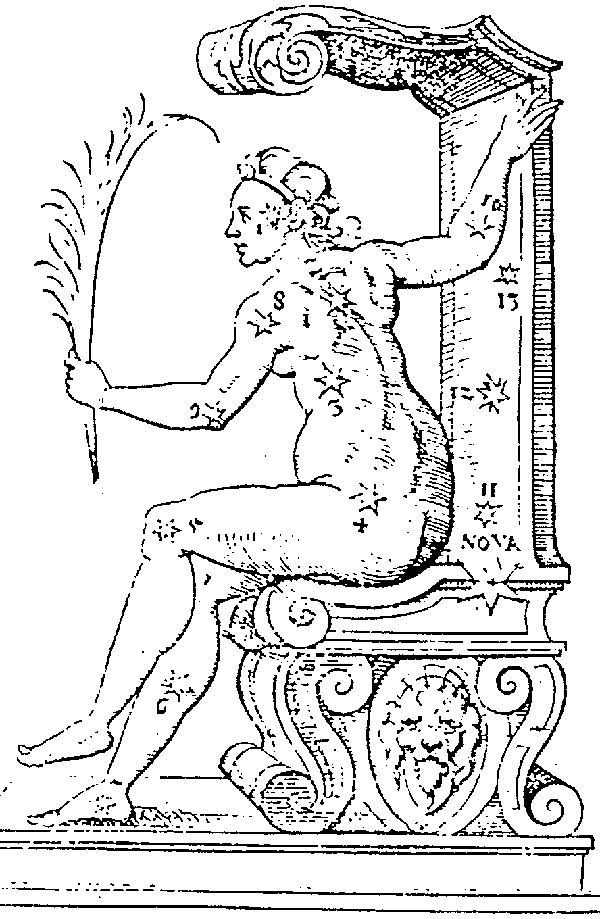 Picture shows the 1572 Supernova in Cassiopeia as recorded by the Czech astronomer Thaddeus Hagecius - the supernova is by the bum of the Ethiopian queen.
Picture shows the 1572 Supernova in Cassiopeia as recorded by the Czech astronomer Thaddeus Hagecius - the supernova is by the bum of the Ethiopian queen.
On 11th November 1572, Tycho was walking back from Steen's laboratory to supper when he saw a bright new star, brighter than Venus where no star had been see before, near Cassiopeia, which then was nearly overhead. Tycho published his observations the following year as De Nova Stella. "Last year in the month of November on the eleventh day of that month in the evening after sunset, when, according to my habit, I was contemplating the stars in a clear sky, I noticed that a new and unusual star, surpassing the other stars in brilliancy, was shining almost directly above my head; and since I had, almost from boyhood, known all the stars of the heavens perfectly (there is no difficulty in attaining that knowledge), it was quite evident to me that there had never before been any star in that place in the sky, even the smallest, to say nothing of a star so conspicuously bright as this."
By careful observations and calculation he reached the conclusion that "this new star is neither in the region...below the Moon nor among the orbits of the seven wandering stars, but it is in the eighth sphere, among the other fixed stars."
 More on Cassiopeia A - its progress: in Nature August 2004
More on Cassiopeia A - its progress: in Nature August 2004
Cass.A now observed as a new neutron star, still blanketed in carbon.
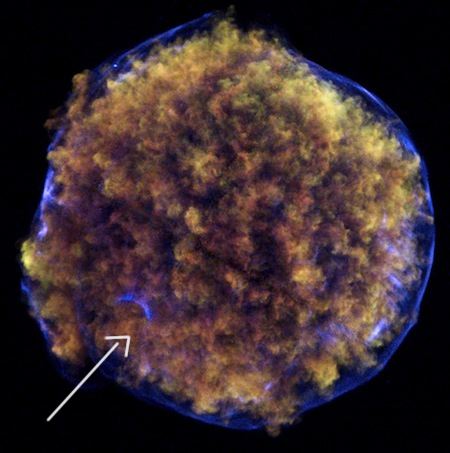 Update on the 1572 supernova. Arrow drawn onto the image observed with Chandra X-ray Observatory, points to remains of shockwave caused when the exploding white dwarf blew surface off a nearby star.
Update on the 1572 supernova. Arrow drawn onto the image observed with Chandra X-ray Observatory, points to remains of shockwave caused when the exploding white dwarf blew surface off a nearby star.
In 1573, the English mathematician Thomas Digges published Alae Seu Scalae Mathematicae based on his observation of the supernova of 1572 in Cassiopeia. Attempts to measure the parallax showed that this new star must be further away than the Moon. Digges supported the Copernican theory of a Sun-centred universe, and showed this was further proved that Ptolemy's model of the universe was wrong, since in that model, taken from Aristotle's ideas, nothing could change above the sphere of the Moon.
In 1575, Tycho was in receipt of a sinecure from the King as well as being rich already and he travelled around Europe visiting and making friends. Frankfurt, Basel, Augsburg, Willenburg, Venice and the Landgraf Wilhelm IV in Cassel who was so interested in astronomy that when told while he was observing the new star that his house was on fire, he finished his work before leaving his tower to put out the flames. He urged King Frederick II to provide Tycho with funds for building his own observatory, but Tycho wanted to live in Basel.
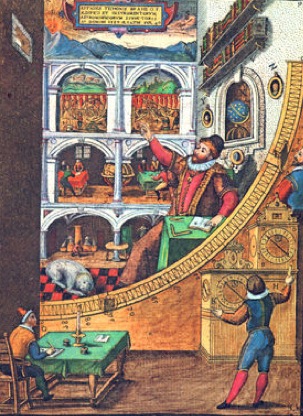 In 1576 Tycho was going to move to Basel but King Frederick II of Denmark gave him the island of Hveen between Denmark and Sweden, Copenhagen and Elsinore "to have, use and hold, quit and free without any rent all the days of his life and as long as he lives and likes to continue his mathematical studies". The King backed this up with an annual grant and the income from various sinecures which gave Tycho one of the highest incomes in Denmark.
In 1576 Tycho was going to move to Basel but King Frederick II of Denmark gave him the island of Hveen between Denmark and Sweden, Copenhagen and Elsinore "to have, use and hold, quit and free without any rent all the days of his life and as long as he lives and likes to continue his mathematical studies". The King backed this up with an annual grant and the income from various sinecures which gave Tycho one of the highest incomes in Denmark.
His main observatory building was called Uraniborg built 1576-1580. Next to it was an underground observatory, Stellaborg, which protected the large instruments like his giant quadrant from the wind.
At Hveen Tycho and his workers made observations and measurements more accurate than any previous. He had two clocks made by Jost Burgi a Swiss clockmaker, which had cross beat escapements invented by Jost Burgi, and were more precise than any other clocks made at that time.
Tycho ruled his workers and tenants despotically. He forced them to work for him without pay, and when they refused, they were forcibly imprisoned in a dungeon he built in the observatory. The observatory also had its own pharmacy, alchemist laboratory and furnace. And a printing press and paper mill, to publish Tycho's work which also included lots of dreadful poetry which he stuck over his buildings.
The island also had game reserves and fishponds. The only thing Tycho missed was his pet elk. The elk had been dispatched to him but never reached Hveen. While spending a night in transit, on the journey at Landskroner Castle, the elk wandered up the stairs to an empty apartment where it found an opened barrel of beer, which it drank. This made it dizzy and on the way downstairs it staggered, fell, broke its leg and died.
Also part of Tycho's household was his mistress by whom he had several children but never married her, as he felt she was socially beneath him. Also beneath him in other ways was the dwarf Jepp who lived under the table chattering all the time, and getting scraps of food thrown at him. Tycho gave many banquets and entertained all sorts including royalty. The young King James VI of Scotland came to see him, in Denmark to meet his bride Anne, although he was really more interested in boys.
In the library at Hveen stood a large celestial globe five feet in diameter of brass on which the stars were engraved in their positions as newly determined by Tycho and his workers. It cost eighty times what was to be Kepler's annual salary. The observatory also had an intercom system which worked by ringing bells.
In 1577 there was a bright comet. Tycho tried to measure the distance of it by its parallax. He measured the position of the comet with respect to the stars at different times during the night - when the comet was high in the sky and when it was low in the sky and compared the results. The comet showed an angle of parallax much smaller than that of the Moon which meant that it lay beyond the Moon's orbit. This was yet another blow to the Ptolemeic system but Tycho did not accept Copernicus's system and compromised. All the planets did revolve round the Sun, but the Sun and planets revolved round the Earth and Moon. This rather cumbersome and unlikely compromise with popular with the Jesuits who also would not accept that the Earth was not the centre of the universe.
Frederick II died of "too much drink" and his successor Christian IV did not like Tycho's attitude to his tenants - and to his King. In 1597 Tycho and his household and effects left Denmark and wandered round Europe until in 1599, the Emperor Rudolph II made Tycho an offer to live and work in Prague. He gave him a choice of castles and offered an enormous salary of 3,000 florins which was a higher income than anyone else in Bohemia.
Rudolph II was very interested in science and magic. Among those he sponsored was Rabbi Loewe who made the Golem which was kept in the loft of the 12th century Gothic Old New Synagogue. The first artificial man or robot, one day it broke free and wrought havoc until deactivated. One day (it is said) the Golem will come to life again. In the Mannerist New Synagogue with its Hebrew clock which goes anti-clockwise which is now a museum, you can see the works of the astronomer David Gans, a friend of Tycho. The Ptolemeic system still. The is also amongst the exhibits a rather odd plan of the universe with the clouds outside the stars.
Tycho moved into the castle of Benatek and starting pulling down walls and rebuilding, announcing his plans in his poems which were stuck all over the walls. A separate gate and section was reserved for the Emperor's visits. Then Tycho found he was unlikely to ever receive his promised salary. Some of his workers had vanished. Some of his instruments had not turned up. The plague broke out and he was expected the keep to Emperor supplied with a secret elixir. His second daughter Elisabeth was having an affair with one of his workers Tengnagel. They were allowed to marry when Elisabeth's pregnancy became obvious and the baby was born three months later.
Also Tycho's enemy turned up in Prague. Ursus - Reymers Bear - who had held the post of Imperial Mathematician before Tycho was given it. Ursus had visited Uraniborg in 1584 and four years afterwards had published a book on astronomy in which he gives the same system of the universe as Tycho who had not yet published it. Tycho was pretty sure Ursus had plagiarized from his papers by getting an assistant to search through his things at night, but he would not have been able to find everything as Tycho kept the most important notes in his pockets. Ursus was annoyed when he found out. He called Tycho half-cracked and said he could make his observations through his nose without needing any other sighting tube.
was born in December 1571 in Weil, South Germany. Went to school then Lutherian Seminary when 13 years old. At 17 went to University of Tübingen. Graduated in arts aged 20, then studied theology. Lost interest in religion soon, and studied astronomy under Michael Maestlin, and maths. Job as teacher of maths and astronomy in Graz. In 1596 aged 25, wrote Mysterium Cosmographicum. Had idea that the universe was built around certain geometrical figures like pyramid and cube. Sent copies out to noted scientists including Tycho Brahe, who invited him to work for him. Moved to Prague with his family in 1600.
So when Kepler arrived in Prague, Tycho was in a bad mood. His son Joergen was in charge of the laboratory. The senior assistant Longontamus was studying the orbit of Mars but got stuck. This nasty problem was given to Kepler. Kepler and his wife and family could not stand the chaos at Benatek and the arrogant attitudes of Tycho's family who regarded the Keplers as beneath them socially.
On 13 October 1601, Tycho was at a banquet at Baron Rosenberg's in Prague. According to Kepler, he could not leave the table, and neither would he (like some of the guests) relieve himself where he was sitting at the dinner table, despite having had so much to drink he was pretty desperate. When he got home he had difficulty urinating at all, and suffered from a fever. He died on 24 October. While he was ill he kept saying that he hoped he had not lived for nothing. He had a fine funeral, and Kepler was appointed his successor. There were suspicions that Tycho Brahe died of mercury poisoning, and may have been murdered. A recent exhumation with forensic examination, showed he may have suffered a urinary infection.
On Tycho's death Kepler took over his observatory and kept all Tycho's papers, despite the complaints of Tycho's heirs. When Rudolph II died in 1612, Kepler moved to Linz for 14 years. Died in Regensburg in 1630.
Kepler's Laws of Planetary Motion
Kepler also worked on designed better cameras and telescopes to use for observation. A mission aimed at detecting planets around other stars was been named after Kepler.
The story continues - with Kepler beginning the next part in the history of Astronomy.
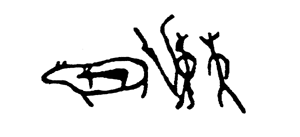 |